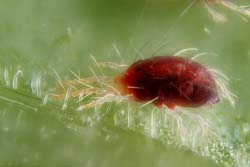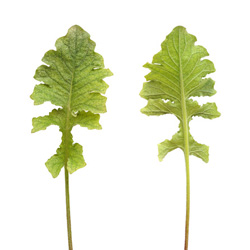Battles in the Salvia Garden: Controlling Spider Mites - Part I

Salvias often suffer when spider mites become legion in gardens. This is Part 1 of a two-part series about understanding and overcoming these dangerous pests.
As summer temperatures rise, so do the numbers of the family Tetranychidae -- spider mites -- especially if conditions are dry. They may appear to be miniscule nuisances, but they cause major damage to ornamental plants, including Salvias.
Controlling spider mites in your Salvia garden may be as simple as keeping plants hydrated and regularly spraying the little nippers off foliage. Or it may take a number of interventions, including biological controls, such as predatory mites, as well as the use of insecticidal soaps, oils and pesticides. We'll discuss these tools in detail in Part 2 of this series.

Meanwhile don't panic if you suspect a spider mite problem in your garden. Here is some advice about immediate steps to take in gaining control of the situation. But first, you need to become familiar with the enemy.
Arachnids, Not Insects
Spider mites suck. No we aren't talking dirty; so don't get ready to wash out our mouths with insecticidal soap. Spider mites have mouthparts that pierce and suck fluids from leaves, which kills plants by impairing their ability to feed themselves through photosynthesis of sunlight.
At about one-fiftieth to one-twentieth of an inch long, spider mites are so small that you may not notice them until Salvia foliage becomes stippled with white and yellow spots. In fact, if you are busy with tasks away from the garden, damage may rapidly progress to major discoloration and distortion of leaves.
Peer under damaged leaves, and you see what appear to be grains of salt until one of the dots begins to move. You may also discover these unwelcome guests robbing juices from buds, petioles and stems.

South Carolina's Clemson University Cooperative Extension reports that the female of one common species -- the Two-Spotted Spider Mite ( Tetranychus urticae) or TSSM -- lays up to 100 eggs in a lifetime of 68 days. The TSSM is a common species that attacks a broad range of plants worldwide.
These prolific pests aren't insects; they are arachnids that develop eight legs by adulthood. Many produce silk webs. According to the University of Florida IFAS Extension, it takes less than a week for many species to grow from eggs into the adults.
There are about 71 genera of Tetranychidae containing more than 1,200 species worldwide. The U.S. is home to 31 genera with 216 species that destroy a wide array of ornamental plants.
According to the Colorado State University Extension (CSU), spider mites thrive and eat more in arid regions, because the dryness allows them to consume more fluids. However, by maintaining plant health and carefully monitoring gardens, you can fight back.
Maintenance, Monitoring and IPM
In 1969, entomologist Everett Dietrick developed an agricultural process called integrated pest management (IPM) that emphasizes beneficial predators instead of poisons for keeping pests under control.

Dietrick founded Rincon-Vitova, the company through which Flowers by the Sea purchases predatory insects and mites for controlling garden and greenhouse pests.
You can also practice IPM on a smaller scale at home by:
- Creating habitat for beneficials by growing plants rich in nectar and pollen
- Maintaining cultural practices that keep plants healthy
- Monitoring (also known as "scouting") plants regularly for pests
- Avoiding pesticides that kill beneficial organisms as well as pests and
- Introducing beneficials, including predatory mites, to your garden.
Habitat Support for Helpers
One of Dietrich's ideas about supporting beneficial predators has to do with avoiding too much of one kind of plant. In agriculture, that's called monocropping. Farmers who follow IPM practices know that their wheat, corn and other cash crops benefit by being intercropped with flowering plants that attract beneficial predators of agricultural pests.
In home gardens, it helps to diversify flowering plants in your yard and to choose ones, including Salvias, which are known as rich supplies of nectar and pollen. Try rethinking your concept of beauty by interplanting ornamentals with umbelliferous herbs (the kinds with flat-topped, umbrella-like flower heads) that beneficial garden critters love. These include anise, cumin, dill and fennel.
Consider your garden not only a cafeteria for pollinators and seed-eating songbirds but also a boarding house for beneficial predators, all of whom pay their keep.
Careful Cultural Practices
Sometimes homeowners accidentally roll out the red carpet for harmful spider mites by allowing plants and parts of the yard -- such as pathways and patios -- to become dusty. Regularly spraying foliage and hosing down these areas decreases spider mites.
Allowing plant soil to dry out too much -- something that can happen rapidly with hanging baskets -- stresses plants. CSU notes that chemical changes which occur in drought-stressed plants make the plants "more nutritious" and attractive for spider mites. Except for extremely drought-tolerant plants, including dry garden Salvias and similarly water-thrifty companion species, most garden plants need about an inch of water weekly.
Remember that overcrowding Salvias and other plants is an excellent way to give spider mites bridges from one plant to another. So consider thinning your plantings if you see an infestation developing.
Another cultural practice to consider concerns what to do when you first discover spider mites. Don't leap to pesticides or insecticidal soaps immediately. Instead, attack with your garden hose by vigorously spraying the pests off foliage and other plant parts. Particularly aim for the undersides of leaves. Hosing spider mites also eliminates their protective webs.
Gardeners as Monitors
Inspect plants about twice a week for spider mites even before damage appears. Equip yourself with a 10x magnifying glass to make observation easier. As already mentioned, the best place to study is the underside of leaves. Another easy monitoring technique involves shaking leaves over a piece of paper then looking for moving dots.
Salvias can seem like bullet-proof plants that never take a hit from pests or other garden ailments. However, that isn't true for all species, especially ones that are vulnerable to tiny bullies called spider mites. Here are some Salvia species to monitor closely for spider mite infestations.
- Salvia wagneriana
- Salvia concolor
- Salvia dombeyi
- Salvia guaranitica
- Salvia gesnerifolia
- Salvia madrensis
- Salvia splendens
- Salvia x 'Wendy's Wish'
- Salvia mexicana
- Salvia involucrata
If you have other kinds of Salvias or companion plants that are suffering from spider mites or different problems, please contact us. We're glad to offer advice.
You don't have to look under every leaf. That would be unrealistic. Instead, when you find a plant that has numerous spider mites, scout a circumference of about 6 feet around the plant, methodically stopping at every, or every other, plant to see how far the problem has spread and the degree of infestation.
Keep notes as you go. You can do a rough analysis based on general estimations of population size, as in "some", "many" and "high density." Or you can scrutinize a few leaves on each plant with your magnifying glass and count the spider mites.
When plants are heavily infested and damaged, it may be best to remove, bag and dispose of them before the spider mites spread further. Few compost heaps are hot enough to completely destroy mites and their eggs, so don't add the the plants to composters.
Pesticides and Other Chemical Controls
Nature is a balancing act. Infestations of pests are more likely to occur if you overuse pesticides that also kill the natural predators of those pests. We'll talk about chemical controls in the second part of this series, including:
- Insecticidal soaps containing potassium fatty acids
- Horticultural oils, such as Neem
- Pesticides for spider mites, which are called miticides
- Neocticnoids and reasons to avoid them
- Pyrethrum products and
- Insect growth regulators.
Spider mites develop resistance to some chemical treatments. Part 2 in this series will also touch on ways to manage this resistance.
Introduction of Beneficial Predators
The ecology of your garden can become out of balance for a number of reasons even if you don't use mitacides and other pesticides. For example, if your neighbors rely on chemical interventions, the numbers of beneficial predatory mites and insects throughout your neighborhood may decline.
To regain balance, it is helpful to enlist the help of commercially raised biological controls, such as hungry ladybugs, lacewings or, in the case of spider mites, predatory mites including Phytoseiulus persimilis and Amblyseius fallacis.
Information about beneficial predators in Part 2 of Battles in the Salvia Garden will particularly focus on the last two species, which are extremely helpful in the FBTS test gardens and greenhouses.
Part 2: Biological and Chemical Warfare
To gain a complete toolbox for battling spider mites, you'll need to the second half of this series for information about types of beneficial predators, their introduction into your gardens and non-lethal chemical solutions.
But if you need some immediate advice, please email or call us at FBTS. We're here to help you keep your garden healthy.

2 Comments